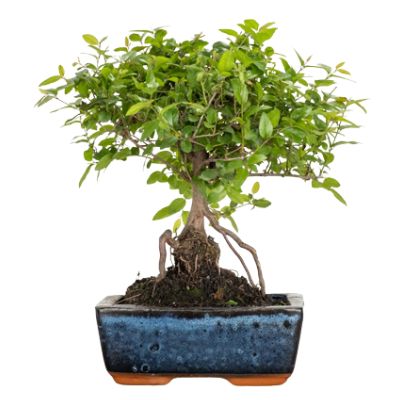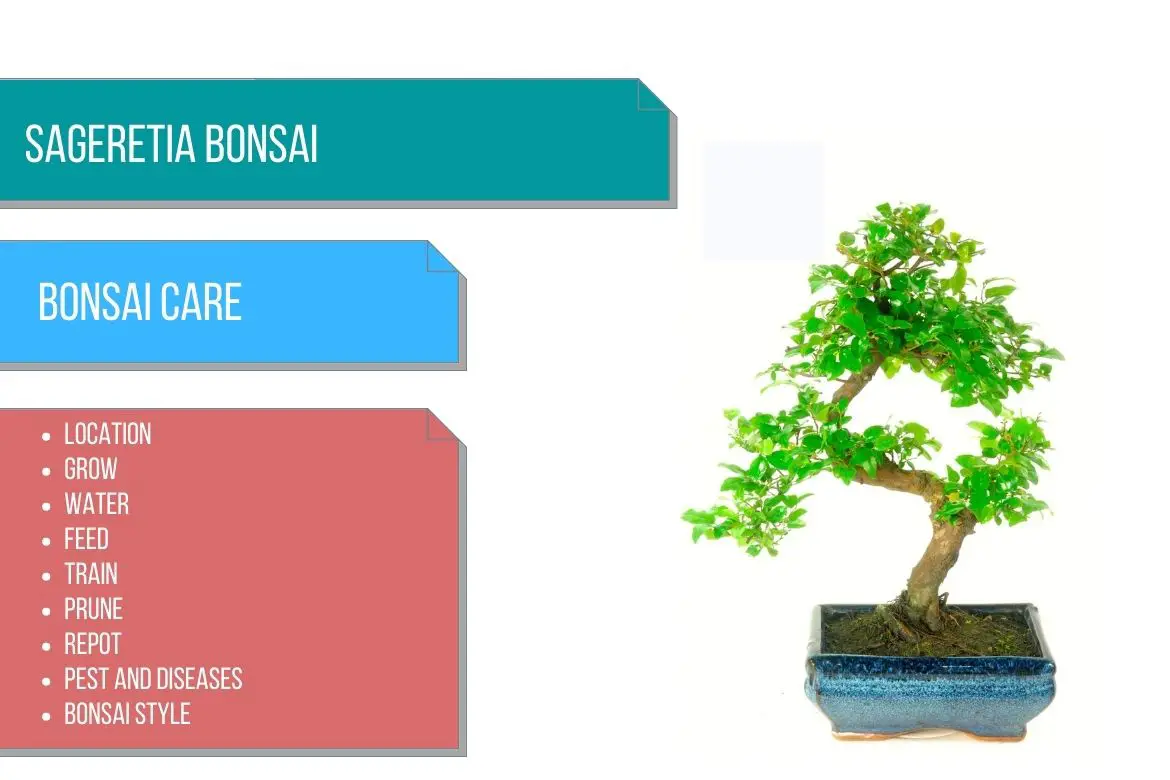
Sageretia
(Sageretia theezans / Sageretia thea)
Country of Origin : Southern Asia
Bonsai Styles : Formal upright, informal upright, multi-trunk, slanting, semi-cascade, cascade
Zone : 5 – 8
Sageretia bonsai tree is widely used in commercial bonsai production throughout Asia. Among the most popular indoor bonsai species, this is an ideal choice for bonsai beginners.
It also makes an excellent bonsai tree in temperate regions.
It has a smooth grayish bark that flakes off in irregular patches, revealing lighter gray shades beneath, giving you a constantly changing trunk appearance.
This peeling characteristics are also displayed by roots and branches that are a few years old. Hence most of these bonsai trees are designed with exposed roots bonsai style.
It has slender branches with occasional thorns. A young shoot is surprisingly brittle, but with time becomes more flexible
Its leaves have an upright growth habit and are borne at very short intervals on the shoots. The leaves are oval, small and have a glossy texture. The tree also produces tiny black colored berries.
In summers, the tree produces white flowers.
Best location to keep Sageretia Bonsai
Sageretia Bonsai tree can be placed in full sun. However, you should provide it some shade to the plant during the days with hot sun.
Sageretia trees like fresh air, so keep them outdoors in summer, if possible, in partial shade.
If it’s chilly at night, bring the bonsai container inside in early and late summer.
This tree is highly preferred for indoor bonsai specimen in cooler temperate countries. When keeping it in indoor settings, keep it in a window which received good amount of sun. You can use a curtain to provide it some shade.
In the summer, the minimum temperature required for its healthy growth is around 64°F (17°C). The three if kept in this temperature even in winter, the tree will continue to grow.
The summer temperature of 65-75°F (18-24°C) is ideal for the plant to thrive. Try to keep it in high humidity.
In winter, the temperature must remain between 54 to 65°F (12 to 18°C).
Refer sunlight requirements for indoor plants for more indoor gardening ideas. Also, refer to do bonsai trees need sunlight for more indoor and outdoor bonsai location ideas.
Propagation of Sageretia
Sageretia tree can be propagated by using softwood cuttings in summer and spring.
Watering Sageretia Bonsai
It is important to keep Sageretias moist at all times.
Be sure to water every day in summer and not let the bonsai soil dry out even in winter. When the growth slows or stops in winter, you can ease off the water.
It is essential to maintain a humid environment around the plant. You can spray the foliage with water to achieve this. Especially in indoor settings.
Read watering bonsai tree for more details about immersion technique.
Wiring Sageretia Bonsai
Wiring sageretia bonsai tree is rarely necessary since the shape is achieved through pruning.
Despite the wide angle at which the shoots emerge from the parent branch, up to 90 degrees in some cases, there should be very little wiring required.
Wiring is best avoided while the shoots are still young since they are surprisingly brittle when they are young, but become more flexible as they mature.
Wire can be applied to hardened shoots at any time of the year, however, if branches need to be wired.
The wire should not be left in place for more than one year.
Pruning Sageretia Bonsai
When to prune Sageretia bonsai?
How to prune Sageretia bonsai?
As Sageretia trees have hard wood, they must be pruned carefully to protect their bark from damage. Use a sharp tool for pruning.
Before the plant starts to grow, remove any damaged or misaligned branches in the early spring.
While pruning can be done at any time of the year, it is best done during the mid-winter months. At a time when growth has slowed or stopped, thin crowded foliage.
However, if you wish to increase foliage density on an underdeveloped branch by vigorous growth, prune the branches back in the mid-summer.
During the growing season, prune vigorously growing new shoots, making sure not to encourage inward growth.

It is especially important that you do not cut through any of the leaves, or else they will discolor and drop.
Shoots and leaves grow prolifically. When branch lines are defined, you can simply clip the foliage to shape it in the same manner as trimming a hedge.
Keep stray shoots off the trunk and main branch line in order to see the tree’s interior.
The best way to analyze the branch formation of any bonsai is to stand the tree on a high table and approach it from below.
Pinching Sageretia Bonsai
Because the shoots are too tough, it is difficult to pinch them with your fingers. You can use sharp scissors.
Repotting Sageretia Bonsai
When to repot Sageretia bonsai?
Sageretia bonsai tree can be repotted every 2-3 years in mid to late spring.
Prune the thick roots using a sharp tool.
Use a deep bonsai pot. It will help in saving more moisture in the soil and also help in increasing local humidity.
You can use a basic free-draining, lime free bonsai soil mix (or Akadama) as a potting soil.
OR
You can also use a soil mix consisting of 60% grit and 40% organic matter.
OR
You can also make a soil mix loam, sharp sand and peat (or compost) in the ration of 2:1:1.
Must Read: Bonsai Soil Recipes
Must read : Choosing the right bonsai container
Feeding Sageretia Bonsai
Apply a balanced feed once every 2 weeks in the growing season.
Reduce the frequency of fertilizing in winters (once a month) when tree growth slows down or stops. If the growth has stopped, stop fertilizing.
Feeding should be resumed two weeks after growth has resumed.
Read more about bonsai fertilizer and its application.
Diseases and pest of Sageretia Bonsai
Young shoots in dense foliage are attractive to aphids, white fly and red spider mites. Spray regularly to prevent infestations. If there are too many insects to remove manually, treat with a systemic insecticide.
Foliage yellowing and loss of vigor may be caused by mineral deficiencies. Add trace elements to the bonsai soil and apply sequestered iron.
The problem of mildew is very serious.
When mildew appears, water the compost carefully. By placing the bonsai pot in a tray of pebbles or gravel, you can improve the humidity around the plant.
Sageretia bonsai care
Cold droughts and dry air are Sageretia bonsai tree’s two biggest enemies.
Provided that they are given enough heat and humidity, Sageretia can be kept indoors or outdoors.
A cold, damp climate or a hot, dry atmosphere can both cause foliage to drop and young shoots to die back.
What to look for when buying Sageretia Bonsai
If Sageretia bonsai trees are kept together on shelves in the nursery, there are chances that the trees will drop their branches. Check the bonsai and if you see any dying foliage, avoid it.
The trunk structure and angles vary from tree to tree. Choose the bonsai specimen which has a trunk line which attracts you.

